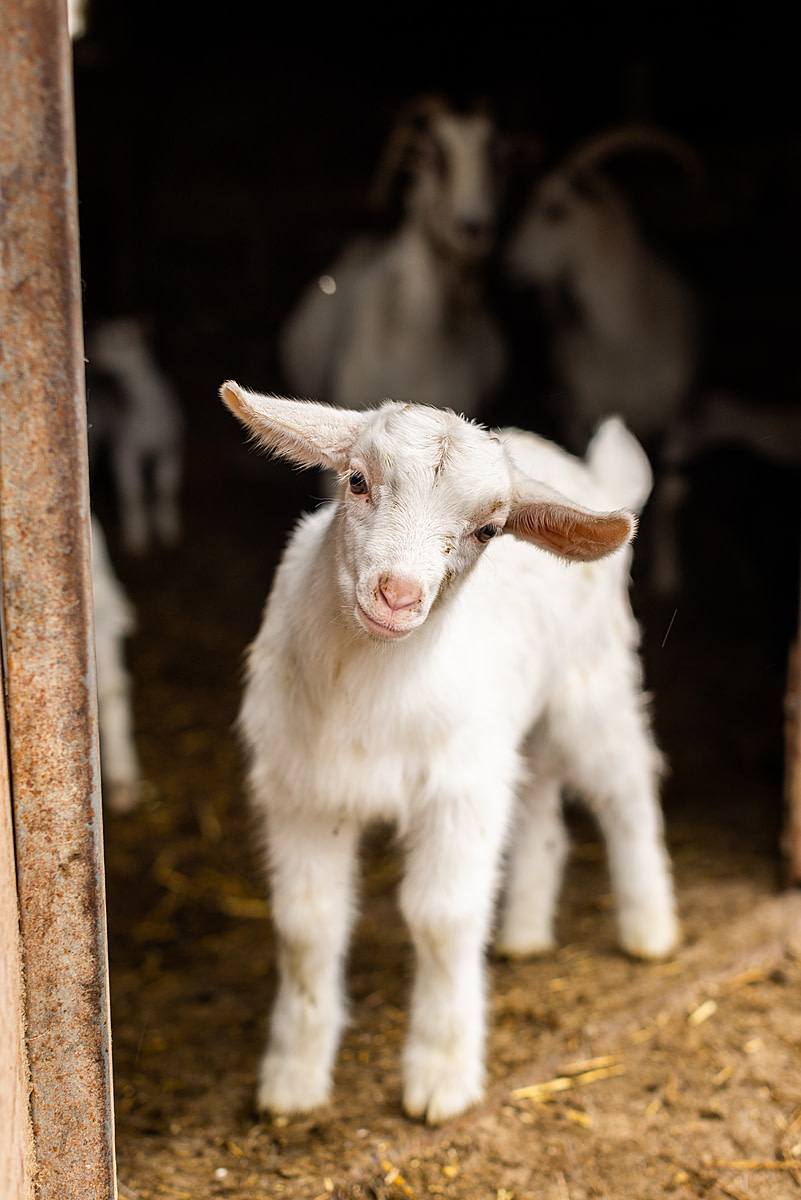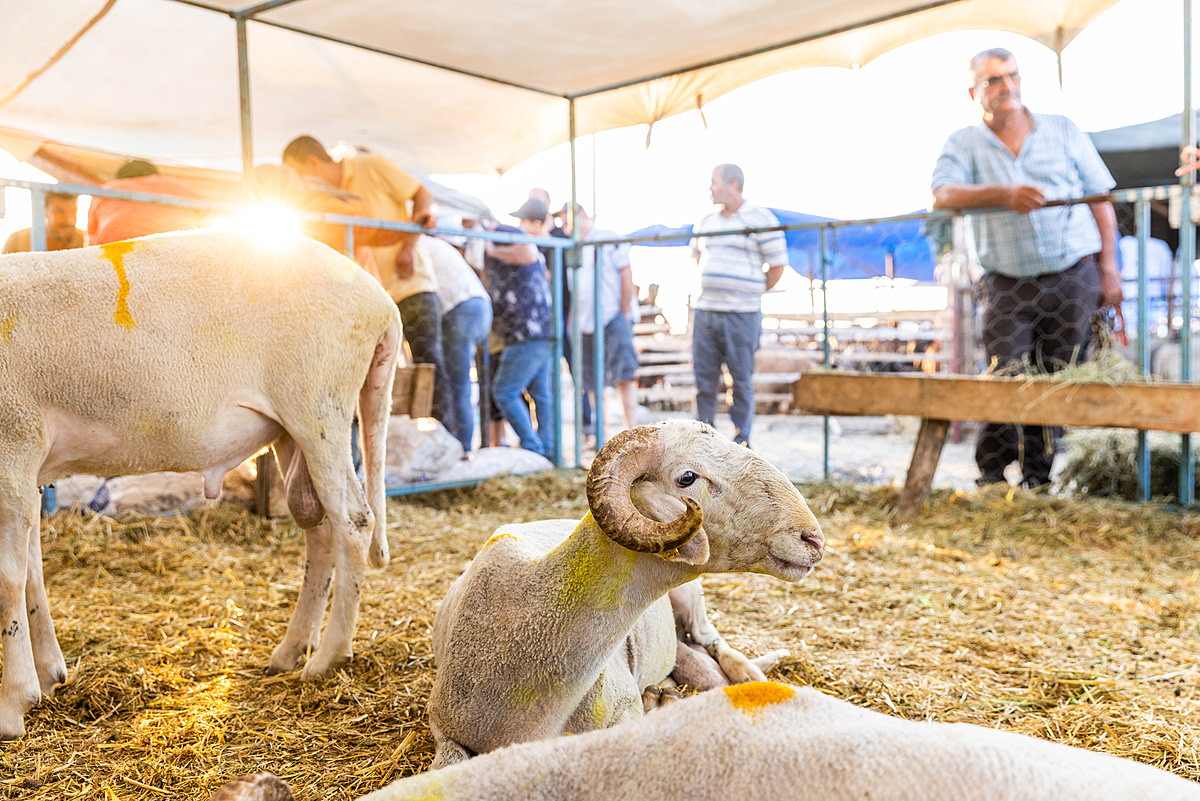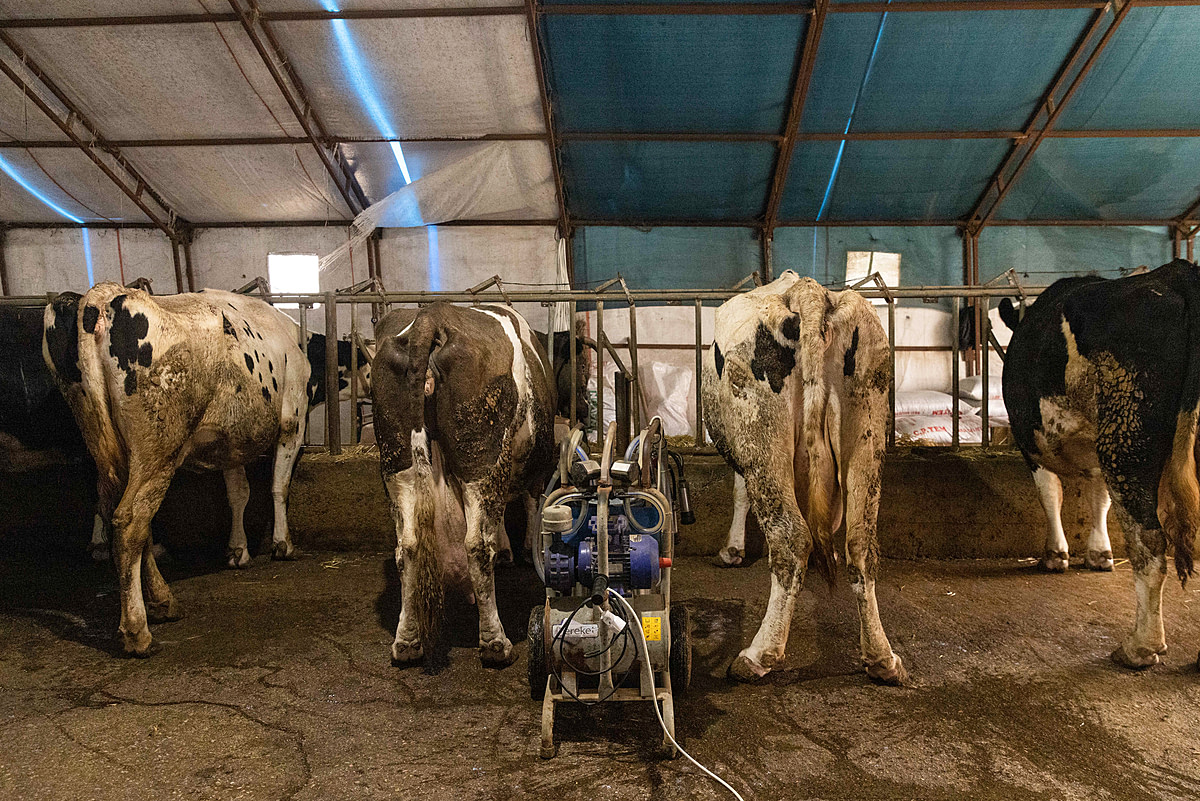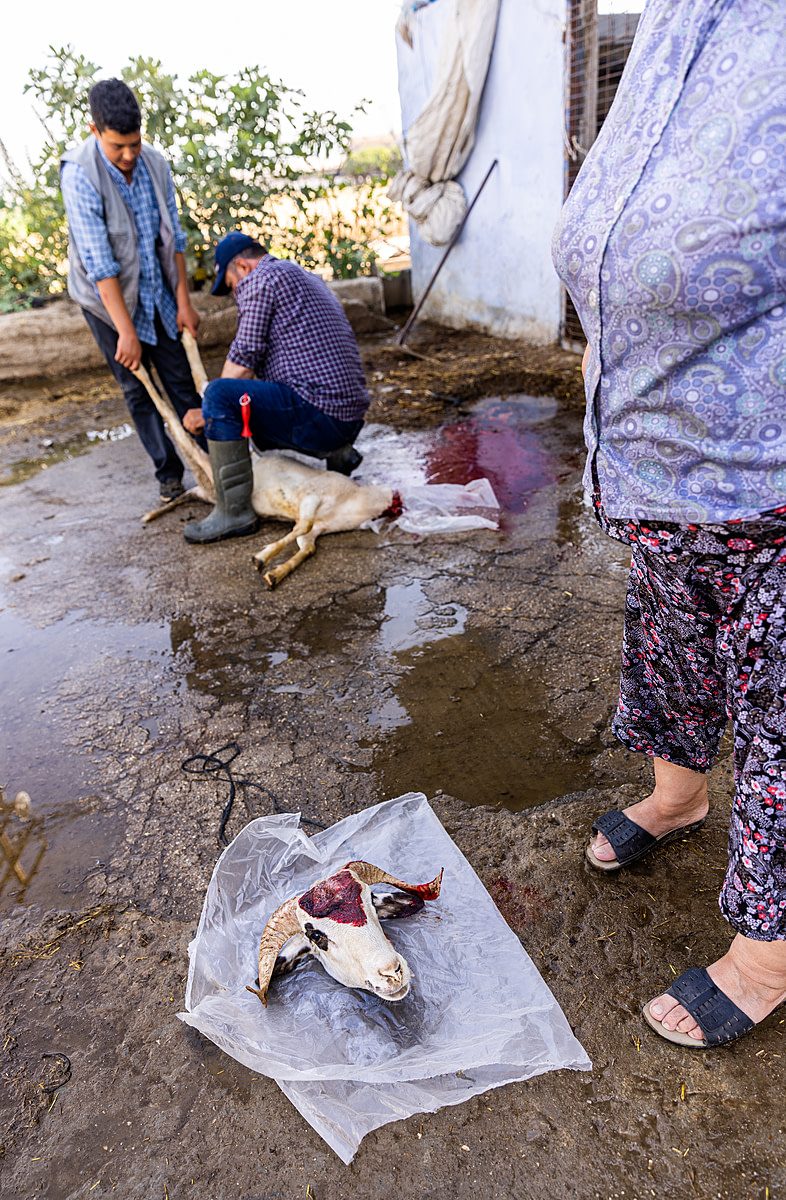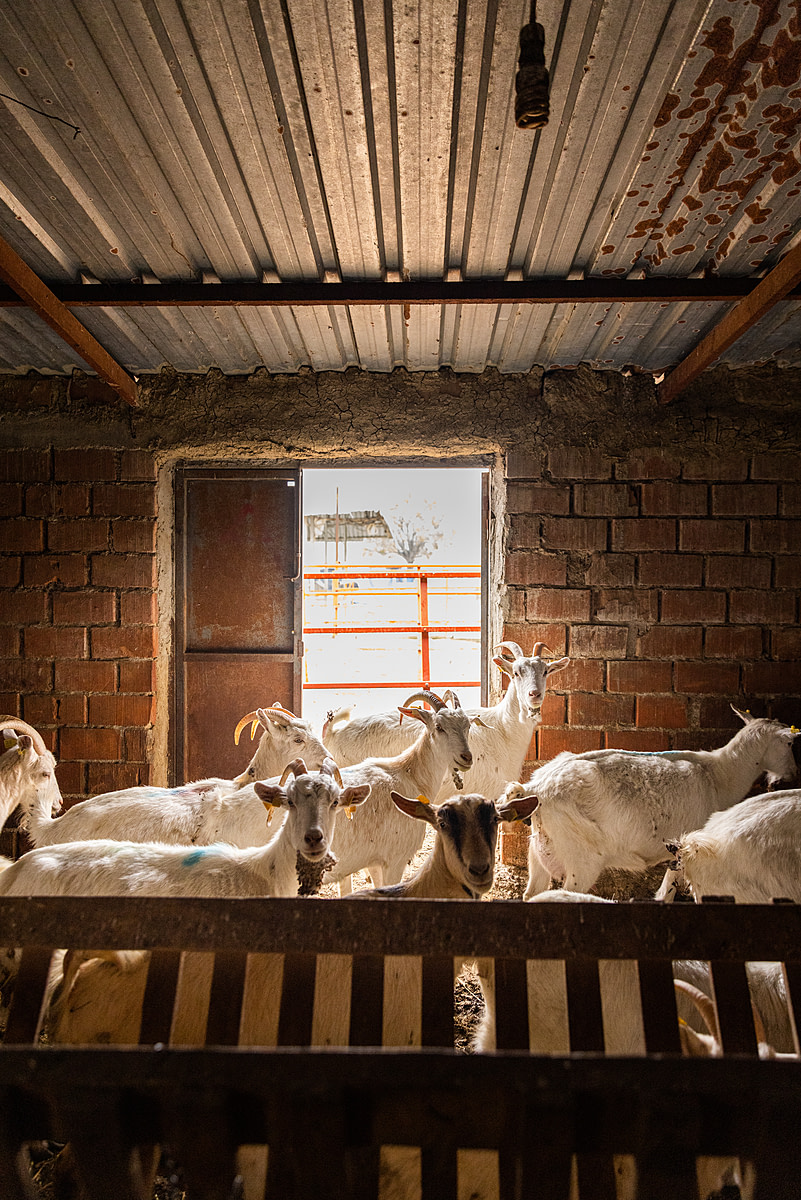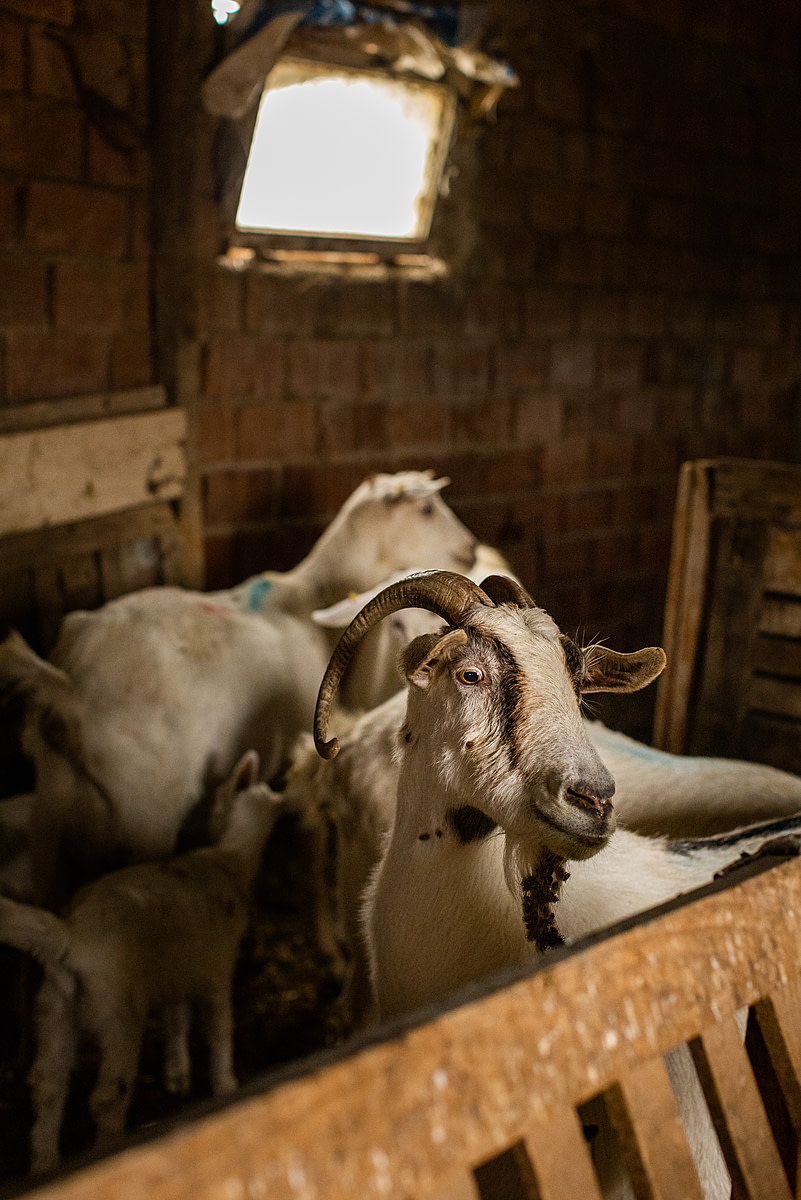We Animals Contributor, Deniz Tapkan Cengiz. Photo credit: Ayse Tapkan
[Content warning: Contains confronting images and/or video footage]
Deniz Tapkan Cengiz is a professional photographer and zoologist living in Istanbul, Türkiye. She has taken photos in more than 60 countries and cities of the world. Vegan since 2014, Deniz photographs and documents animal lives, combining her zoology background, vegan culture and photography for animal liberation.
We sat down with Deniz to learn more about her journey into animal photojournalism.
Follow Deniz’ work: Farm Animals Politics
Interview by We Animals.
All images by Deniz Tapkan Cengiz.
Which came first for you: animals or photography? Can you tell us a little about your path to where you are today?
Animals came first for me. I studied zoology at university and after graduating, I worked as a zoologist at the zoo. I was responsible for creating the living conditions for the animals. I was also conducting ethological studies. During these studies, I started to use the camera as a tool. Then I quit my job and thanks to my new profession, I had the chance to visit more than 60 countries and cities around the world and take photos in these places. Animals were always in my frame.
A kid goat intently stares as they investigate the photojournalist’s camera on a goat dairy and meat farm. Although they may perceive the camera as a threat, these young goats exhibit high focus and curiosity. Turkiye, 2023.
Deniz Tapkan Cengiz / We Animals
Two years ago, there were huge fires in Türkiye. The places where I lived in my childhood burnt down. The fires could not be extinguished for days. The government did not even have a fire extinguishing aircraft. They didn’t know how to deal with such a big problem. For the first time, Türkiye faced global warming in such a sharp way.
I had a lot of knowledge about global warming due to my background in zoology and my 10-year vegan background, but we had never seen endless fires before. We learnt that it is very painful to face the practical part of theoretical knowledge. At that time, I remembered that I had heard that there were endless fires in Australia and I opened my computer to do research on the subject. During this research, I saw a photo of a kangaroo alone with its baby in the middle of the burnt forest. That kangaroo introduced me to Jo-Anne, and then We Animals.
As a result, I decided to work for animal welfare by combining my zoology background, vegan identity, photography and video production skills.
A man arranges recently caught fish that are laid out on a beach in Negombo, Sri Lanka. Fish are spread out in this large outdoor area in order to dry in the sun before being sold at a market. Fishing is the primary occupation of the people in Negombo. Sri Lanka, 2019.
Deniz Tapkan Cengiz / We Animals
What’s happening in animal photojournalism in Türkiye?
I wouldn’t be lying if I said very little. But I am witness to the fact that vegan culture is on the rise, and that we cannot underestimate. We are far away from the laws that should be related to animal rights. I think the people who will create these laws, the people who will look at the place of animals in our world with respect, who will evaluate them correctly by moving away from the anthropocentric point of view are very few in our country. Almost no one in the parliament is interested in this issue. Therefore, animals find very little space in journalism and news reporting. Based on all these reasons, I can say that almost no energy, effort and time is spent on animal photojournalism.
In Türkiye, cats and dogs living on the streets occupy the biggest area on the agenda about animals. There is no good management and supervision process on the subject. Society is divided into those who want these animals to be put down and those who say that they should be sterilised and left in their place. As in everything else, we have become a polarised society. A video of a person who killed a dog with a shovel went viral all over the world. As a result, the person received a very light punishment.
Baby goats in a holding pen on a goat dairy and meat farm. This farm separates the kid goats from their mothers until after the mothers are fed. Once allowed to reunite, mothers and babies must find each other by searching and recognize each other by voice and smell. The smaller goats have trouble finding their mothers. Turkiye, 2023.
Deniz Tapkan Cengiz / We Animals
Is there any particular visual you’ve created that you think represents your work and what you’d like to communicate to the world particularly well? Tell us why.
Actually, my photography work is mostly done on farms, but the example I want to give here is from a zoo. This photo of Jane, a chimpanzee, and her baby Gina has left a deep impression on me.
This is a photo I took when I was working at the zoo. Jane had a baby. She was the centre of everyone’s attention. Jane, tired of this attention, would not show the baby. One afternoon when I went for a walk around the garden with my camera, I saw Jane breastfeeding Gina. Normally she would have stopped immediately and taken the baby inside. But she didn’t. There was no one watching her but me. And she let me. She let me see her baby, take a long look at them, and even take pictures. For me, it was a powerful and magical moment of communication with an animal without speaking. The evening sun was setting in Jane’s honey-coloured eyes.
Mother chimpanzee Jane stares into the camera as she breastfeeds her young infant at the Faruk Yalcın Zoo, in Danica. Turkiye.
Deniz Tapkan Cengiz / We Animals
Like many of the animals I photographed, Jane is no longer alive. According to the news I received when I left my job, one morning the zookeeper found Jane lying on the floor with broken ribs. The male, Gina’s father, had killed Jane. It’s a stressful life for animals in a zoo, and each species reacts differently to this stress. After Jane’s death, the male chimpanzee continued to show violence to both girls, so they separated the father from this environment. Gina has been growing up without a mother and father from a very young age.
Normally, chimpanzees learn motherhood by observing other mothers. Jane never had such a chance because she spent her whole life in the zoo. But she was a very good mother.
How much creativity can you as a photographer bring to a scene? You’re reporting as a journalist, but how much are you also trying to include your perspective as an eye-witness, as well as your own creative expression?
I must say that I keep my creativity in second place during animal photojournalism. The story comes first for me. The subject is not me, but the animal in front of me. I try to understand them; I start to observe the environment they live in, what kind of ground they step on, what kind of containers their food and water is in, their contact with the external environment, the way people treat them. But having a developed photographic eye can be useful in such difficult and fast moments.
Since I have been working with animals for a long time, I can give the right answers to my questions such as how to get near them, how to make the first contact or whether I should make the first contact. This is a great advantage for me.
I think the most important issue is time, and the more time I spend working, the greater the depth and creativity. I go to the same place and the same animal many times and spend longer and longer.
Sheep for sale inside a pen at an animal market before the Eid al-Adha “Feast of the Sacrifice” celebrations in Turkiye. Buyers come to these markets to choose an animal to slaughter for this traditional Islamic holiday. Purchased animals are tied up and forced into cars to transport them from the market, causing stress and anxiety to the remaining animals who witness this nearby. Türkiye, 2022.
Deniz Tapkan Cengiz / We Animals
Sheep raised indoors for their wool, milk, and meat eat from a trough by placing their heads through automatically locking stanchions. The head space for each sheep is approximately 10 centimetres apart. The farm uses the stanchions to increase farm labour efficiency by medicating, milking, cleaning and shearing the sheep while they eat. Turkiye, 2023.
Deniz Tapkan Cengiz / We Animals
If we want to transform individuals and ultimately societies through our photographs and videos, I think we need to think more about empathy. Some of our experiences are very harsh and painful. These are the kinds of images that other people don’t even want to see. So they won’t empathise with the images they don’t look at for a certain period of time and they won’t create any change in their lives. Through my photographs, I am trying to create the moment of “empathic encounter” that philosopher Edith Stein first articulated. I want to create photographs that people can connect with and experience that breaking moment in order to create the motivational chain that leads from values to change.
This year you documented the lives of animals inside Türkiye’s dairy industry, including cows, sheep and goats. In 2022, Türkiye became the first country to outlaw the production of plant-based dairy products, an indication of the industry’s influence and power. Can you tell us about your experience documenting these stories at such a critical time?
Vegetable-based cheese production is banned in Türkiye. All other products are accessible. This issue actually has a political angle, but I don’t want to say anything more because we live in a society that has lost its freedom of expression.
I shoot in “natural” farms. I observe the animals where the villagers buy as many animals as they can buy according to their budgets and where they produce animal products. But I also encountered in these small farms the conditions we would see in industries where too many animals are confined. For example, there was a one-week-old calf in the farm I went to for my last shoot. They were standing in a separate place from their mother. The mother’s milk was milked with a machine and given to the calf through a bottle. When I asked why the farmer did this, he said “it was easier”.
A portable milking machine sits between cows standing at stanchions on a concrete-floored “natural” dairy and veal farm. Unpackaged milk produced from the farm’s cows is sold in a nearby city centre, where it is reputedly preferred by customers believing unpackaged milk to be organic. Turkiye, 2023.
Deniz Tapkan Cengiz / We Animals
There was a similar situation on the goat farm I visited. All the goat kids are together but separated from their mother. During breastfeeding, the door between them is opened and the babies look for their mothers and mothers look for their babies. After five minutes, there are very small babies who still can’t find their mothers. They want to suckle. They start sucking as soon as you extend your finger.
In the sheep farm, I saw locked feeders, which can be locked as soon as the animals put their heads into the feeder to eat hay. Thus, the farmer can treat the animal as he wants (vaccination, trimming etc.) The animal can be locked against their will.
And of course, the most basic problem we see in every farm is that none of them have sufficient space. They are always crowded there is no personal space, as if they are not individuals.
Sheep raised indoors for their wool, milk, and meat eat from a trough by placing their heads through automatically locking stanchions. The head space for each sheep is approximately 10 centimetres apart. The farm uses the stanchions to increase farm labour efficiency by medicating, milking, cleaning and shearing the sheep while they eat. Turkiye, 2023.
Deniz Tapkan Cengiz / We Animals
Kid goats run to find their mothers after being released from a holding pen on a goat dairy and meat farm in a barn containing approximately 200 goats. The farm separates the baby goats from their mothers, allowing them to suckle only after the mothers have been fed. Turkiye, 2023.
Deniz Tapkan Cengiz / We Animals
In 2022, you documented animal markets and slaughter during Eid al-Adha—one of the main Islamic holidays celebrated in Türkiye. Can you tell us about your experience on the ground capturing these visuals?
In a word, horrible. It took me four months of convincing myself to decide to document the victims. I asked myself if I would be able to do it, if I did, would the effect last too long, how would I cope with the images that I could not erase from my memory. Actually, I should say from the beginning that in Muslim countries this is a childhood trauma. The sheep to be sacrificed is bought, fed and loved a few days in advance, sometimes even a month in advance. They are cared for as if they were a cat or a dog of the family and as a result a bond is established. After all this, while adults know what will happen on the feast of sacrifice, children do not. The sheep they have loved until that day is slaughtered and put in front of the child on a plate. Some families make the child watch the slaughter. There are even customs such as taking the blood of the victim and rubbing it on the forehead of the child.
But I had never come across this, thanks to my family. I took photos of the slaughter in a village in Manisa. While the slaughter place was being prepared, I entered the place where the animals were. It was divided into two sides. On one side were the ones marked in red (sold) and on the other side were the ones that would not be slaughtered. They brought a ram and laid him on the ground for slaughter in front of the person who had bought them. The buyer said “I will take the head” and he cut the ram’s throat. I was recording these moments. I felt my whole body trembling. It was a tremor that could make me drop the camera from my hand. The animal suffered longer than normal. It is very difficult to describe the image at that moment. I couldn’t look any longer, so I turned my head to the right while holding the camera steady and started to cry. At that moment, I saw the sheep waiting nearby, watching the slaughter without taking their eyes off. They were obviously scared. Maybe they were shaking like me.
Men begin butchering the body of a decapitated ram in a courtyard in Turkiye. This sheep was killed while fully conscious as a ritual animal sacrifice or Qurban, so his owner could observe the traditions of the Islamic Eid al-Adha celebrations. As part of this religious holiday, millions of animals die in Turkiye alone. Türkiye, 2022.
Deniz Tapkan Cengiz / We Animals
A sheep is pulled from a pen by their horns at an animal market in Turkiye. Buyers come to these markets to choose an animal to slaughter in preparation for the “Feast of the Sacrifice” component of Eid al-Adha, a traditional Islamic holiday. After purchase, the animals are tied up and forced into cars to transport them away for slaughter. Türkiye, 2022.
Deniz Tapkan Cengiz / We Animals
A man drags a sheep along the ground by their horns to remove them from a pen at an animal market before the Eid al-Adha “Feast of the Sacrifice” celebrations in Turkiye. Buyers come to these markets to choose an animal to slaughter for this traditional Islamic holiday. The animals are tied up and forced into cars to transport them from the markets. Türkiye, 2022.
Deniz Tapkan Cengiz / We Animals
Then they divided the animal into edible and inedible parts. As a vegan for about 10 years, I thought about how big and deep the illusion of eating meat is. I was the odd one out compared to the people holding a heart in one hand and a liver in the other while the animal’s head and blood were on the ground.
I talked about the subject of sacrifice with Havva Zorlu, another one of We Animals’ photojournalists. Her experiences are also very valuable. The interview published in a Turkish national newspaper can be read here.
Who inspires your work? Do you have any top photography influences?
I am more impressed by scientists working to understand animals than by photographers, such as the primatologists Jane Goodall and Frans De Waal, who have given us their valuable observations through their books. And of course Jo-Anne McArthur. After I came across the kangaroo photo, some issues made sense in my mind and I decided to study these stories through my camera. I also think that the stories of all the We Animals photographers are very valuable. I learn a lot from them.
When preparing for a field assignment, what’s your go-to camera bag kit?
It is very important for me not to have unnecessary weight in my bag because I have four hernias in my neck. I generally have an arm and neck pain problem. Therefore, I keep my equipment limited. Canon R5, lenses (Canon RF 24-70 mm, Canon 50 mm f 1.2), memory cards, extra battery and charger. If I plan to shoot video, I also take my Zhiyun Gimbal with me.
Many people would find it too difficult to photograph what you do. What helps you overcome the difficulties inherent with this kind of photojournalism?
It is very difficult for me too. And I can’t say that I cope with this feeling very well. Because we look closely at these sufferings, our experiences turn into feelings and behaviours that we cannot deny. And I think one can cope with this difficult feeling only if one has a purpose. In the last analysis, the point at which I can comfort myself is that I have made it my mission to work for animals.
Adult goats intently stare at the photojournalist’s camera inside barn containing approximately 200 animals on a goat dairy and meat farm. This farm separates the baby goats from their mothers, allowing them to suckle only after the mothers have been fed. Turkiye, 2023.
Deniz Tapkan Cengiz / We Animals
If you could issue an invitation to other photographers to take up animal photojournalism, what would you say?
Those who breathe are those who must survive and therefore those with whom we must fight. Money does not breathe, the flag does not breathe, insurance and legal systems and borders and religions do not breathe. It is only people, animals and nature that breathe. And this struggle is very valuable.
The influence of the media in transforming societies is indisputable. If there is a media that is principled and concerned about the future of society – and for a long time we have rarely met them in Türkiye – I would like to remind them of the principle of equality. But not only equality between humans, also the “principle of equal consideration of interests” mentioned by Peter Singer, which includes animal interests, i.e. animals with the capacity to feel pain and pleasure. In order to create a society that accepts this principle, I think that attitudes and behaviours against the principle of equality should be questioned and reflected in the media.
A curious sheep for sale at an animal market looks into the camera from inside a holding pen on the first day of the Eid al-Adha “Feast of the Sacrifice” in Turkiye. Buyers come to such markets to purchase an animal for slaughter so they may observe this Islamic religious tradition. Türkiye, 2022.
Deniz Tapkan Cengiz / We Animals
What’s next for you in your work? Are there any particular animal stories you’re particularly compelled to document?
The next step is an important one for me because I am starting a masters programme on farmed animals. Although I have not determined the specific topic, most probably my field of study will be the separation of the calf from the mother. In this study, I plan to use my camera as a tool and, if possible, create a short film with the recordings.
I also have a study topic that was postponed from last year to this year (due to the earthquake) and that is camel wrestling. There is a tradition in Türkiye where approximately 3,000 camels are bought, sold and wrestled. I plan to shoot this subject.
Follow Deniz’ animal photojournalism: Farm Animals Politics
Interview by We Animals.
All images by Deniz Tapkan Cengiz.
Explore a selection of Deniz’ visuals via our stock collection.


